We’d like to thank Shilpi and Amit Mehta for hosting the potluck dinner last night. My talk was on “Common Pitfalls of Paleo,” and it was a pleasure to meet so many Paleo enthusiasts, including people we knew from PaleoHacks, email, comments, and Facebook.
We brought pumpkin soup to the potluck, and that will be our food post this week. But we’ve had some questions about bone broths, so let’s revisit that first.
Making a Tasty Broth
Earlier, we discussed making a broth from ox feet (Ox Feet Broth, Miso Soup, and Other Soups, Jan 2, 2011). The advantage of feet (ox feet, chicken feet) or tails (ox tail) is that they have a lot of connective tissue, so they make a gelatinous broth full of nourishing collagen.
However, you can make a good broth from any bones, and it’s possible to find marrow bones that also have some connective tissue. With longer cooking, you can extract collagen and minerals from the bone itself, and get a good broth from these larger bones.
We’ve found, on limited data so far, that bones from grass-fed animals from local farms seem to produce a tastier broth than supermarket bones. I’d be curious to hear if others have had the same experience.
A few other tricks can help make a tasty broth. One tactic that seems to work is to discard and replace the cooking water at an early stage.
Here’s what we do. In this case, we started with a mix of beef and pork bones:
As you can see some blood comes out of the bones, especially the pork bones, almost immediately. This may be responsible for the poor taste some experience.
We put the heat on very low and let the water warm up gradually. Before it reaches a boil, after an hour or less, it looks like this:
At this point we drain and discard the liquid, adding new water. It now looks like:
You can see the marrow inside the pork bones, which will fall out before we’re done, and the ligaments and tendons in the joints, which will produce a nourishing gelatin. Bits of meat and fat will also be released.
After some hours of cooking, all the meat and fat and most of the marrow and connective tissue will have fallen off the bones. It will look something like this:
At this point you can pour out the broth into a container and use this fatty, meaty broth for rich soups. Seaweed, vegetables like tomatoes and onions, and thinly sliced beef, tendon, or pork bellies go well with this broth. We often use it for Pho (Vietnamese Noodle Soup) (Feb 27, 2011).
Add water and acid and continue cooking. This second round of broth will mainly contain minerals and some collagen, and will need longer cooking.
In the second and later rounds of cooking, we add an acid to help extract minerals from the bones and expose the collagen matrix. Lime juice, lemon juice, and vinegar all work well. We especially like the juice of a lime, and rice vinegar, which gives a slightly sweet taste; others seem to like apple cider vinegar, which is more acidic.
Here are our beef and pork bones early in the process:
And here they are later:
The bones will be obviously softening by this point, as you can tell by poking them with the tine of a fork.
If you wish, you can once again collect the broth, add new water and cook again. Every successive broth will be lighter. In the third round, with long enough cooking, the broth becomes white, like this:
I have heard that in earlier times, when food was costly but fuel cheap, that bones would get cooked until all the nutrients had been extracted – for as long as a month.
Pumpkin Soup
Pumpkins are abundant in New England in October, and we love pumpkin soup.
Here are the ingredients – garlic, onion, and pumpkin:
On very low heat, gently cook the garlic and onion in 3 tbsp butter:
Then add the diced pumpkin and enough bone broth to cover:
Bring to a simmer but don’t boil. When the pumpkin is cooked, after about 20 minutes, use a hand blender to puree the pumpkin-onion-broth mixture in the pot. It will look like this:
Add salt, pepper, cinnamon, and nutmeg to taste, and 1 tbsp rice syrup for a touch of sweetness. Add curry, or other spices, if you like a more flavorful soup. Serve hot, adding a dollop of sour cream if you like a richer, fattier taste:
A delicious autumn appetizer! It can even serve as a meal by adding meat and vegetables to the soup.







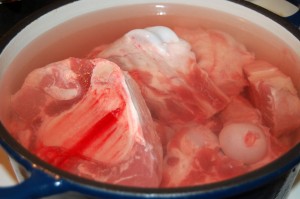
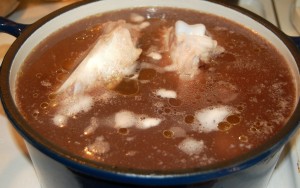
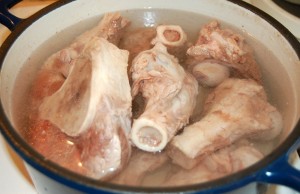

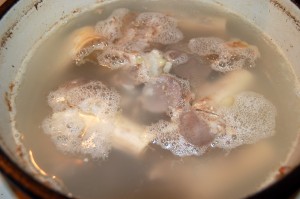
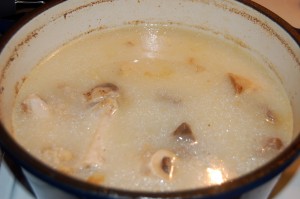
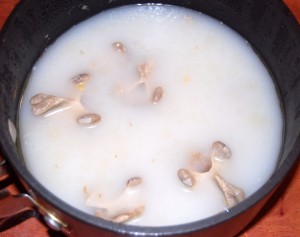
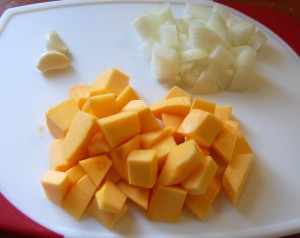
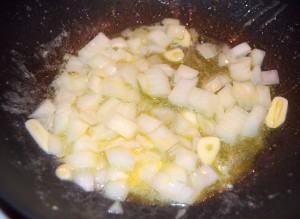
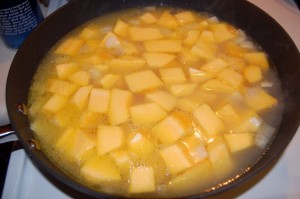
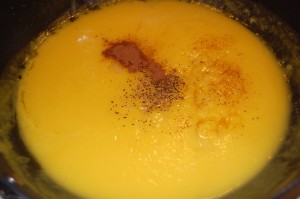
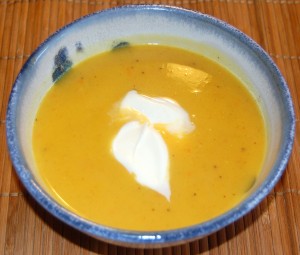




I have a really simple and delicious bone broth recipe on my blog as well that readers may enjoy- it’s a beef & garlic broth but can be made with other types of bones as well.
Enjoy!
http://balancedbites.com/2011/04/easy-recipe-mineral-rich-bone-broth.html
I’ve read that roasting the bones first improves the flavor. Is there a health reason you don’t do that?
Thanks, Diane! I like the introduction to your broth post.
Hi Beth,
There’s no health reason, more that this method is simple and works.
Roasting the bones might be healthier, if it kills bacteria. But the temperature should not go so high as to oxidize the lipids or form other toxic compounds. Also, roasting won’t remove blood or impurities as the water does. So I think gentle cooking and discarding the released blood and surface contaminants is probably, on balance, healthiest. It also tastes great.
Thanks. BTW, I’m intrigued by this idea of using a specific type of pressure cooker to make stock: http://www.cookingissues.com/2009/11/22/pressure-cooked-stocks-we-got-schooled/ … just not sure it’s worth spending the $$ for my palate ;).
I have a slow cooker recipe for bone broth on “10 Minute Meal” at http://10minutemeal.com/basics/bone-broth/
Sally Fallon in her broth recipe says that you should roast the bones for “flavor and color.” Roasting may eliminate the need for the step you have for discarding the water early on. I found that roasting the bones took a lot of time and so I would frequently skip that. Until I discovered that I could microwave the bones for 10 minutes and that gave a result similar to oven roasting. And it does improve the flavor.
The bone broth photo series is very interesting; thanks for including it! I have made bone broth several times using the Nourishing Traditions recipe (beef bones) and a slow cooker, including about 2 lb knuckle bones, 4 lb marrow bones, and 2 lb meaty bones. I add vegetables (less than recommended in the NT recipe, as the bones take up too much room in my 7-qt slow cooker) and cover with water, then simmer for 36 hr. At no point does my broth look like any of your photos — it’s darker and clearer at 36 hr. It does gel somewhat in the fridge afterward, and tastes delicious. But it seems it should gel more than it does. I wonder if I’m not getting the maximum nutrients? Or perhaps I am overcooking it? Hm…
Hi, Paul — another fantastic recipe post. Our family enjoyed your Cambridge fried rice this weekend quite a bit. Our slight variation was to add tamari with the butter when cooking the eggs and a bit of tamari at the end as well.
Here’s my wife’s bone marrow Paleo Pho recipe (or Vietnamese beef soup): http://www.latestinpaleo.com/blog/2011/3/22/latest-in-paleo-pho-recipe-vietnamese-beef-soup.html
I make broth every week (it’s my favorite weekend chore). I’m lucky because my butcher gives me beef marrow and joint bones for free (huge ones)–they just discard them otherwise (broth is now a lost art in Greece). And I collect all the bones I’ve accumulated from eating nice cuts of meat.
For the acid (to leach out the minerals), I use red wine and tomatoes. Works great and adds to the flavour. I simmer this watery concoction overnight for about 16 hours (never discard anything) and then add some finely chopped vegetables (onions, carrots, celery, whatever I have, etc). This is simmered for another 4-6 hours. In the last hour, I drop in some herbs and spices (parsley, rosemary, thyme, oregano, etc).
I think it makes a fantastic broth. I drink six ounces a day. Kids love it too. So versatile, as well. We use it to make soup and cook rice with. We also use it liberally in cooking other meals too.
I’ve heard other people recommend to discard the layer of fat that forms on the top (we don’t). Anyone else heard about that? Isn’t that where most of the marrow would partition?
I love bone broth, but sometimes I find it difficult to include them in my diet on a regular basis. In this situation I have found that adding a lite bit of gelatin powder to my omelets is a nice strategy for getting some gelatin into the diet.
I wonder if the traditional warning to skim during the initial simmer would eliminate the need to throw out the first batch?
Here are my ruminations on chicken broth
http://www.themodernhomestead.us/article/Chicken+Broth.html
@ Holly
Harold McGee, who writes books on food science, says this:
“Optimum extraction times depend on the size of the bones and meat pieces and on the age of the animal; the more cross linked collagen of a steer takes longer to free than the collagen from a veal calf. At long extraction times, the gelatin molecules that have already been dissolved are gradually broken down into smaller pieces that are less efficient thickeners”
So it helps to know from whence came the bones you are using in order to ascertain whether you are over cooking or under cooking.
But then I still wonder: if you have overcooked it and extracted the gelatin but then broken it down, how much does that change the nutritional value?
Your post and the photos that went with it were very good at showing the step by step of making different kinds of bone broth. The darker bone broths seem
More common in the west but Korean like their bone broths to appear white and milky. But the dark bone broths seem to have so much flavor while the milky ones are pretty bland and tasteless, at least that is my experience.
Paul,
It was great meeting you on Sunday! If you could email me any slides you wish to share as we discussed, I’d appreciate it.
I’ve been told that adding ginger to your chicken broth is a good thing. I’ve been doing it myself and the broth is delicious. Might be without ginger too. 🙂 It doesn’t taste like ginger in any case.
My method: soak the bones in very cold water with some acid. Usually vinegar. After a few hrs, bring to a boil and skim like crazy. Then lower the heat. Add veg at this point, like onions, carrots, parsnip,celery, garlic, ginger. If there is any meat on the bones I take it off once it has cooked through and is tender and reserve that for soup later or use in a salad/etc. And throw the bones back in. I usually start on a Friday morning and let it go until Monday eve. If I am using chicken bones I try to crack them when they get soft. I always end up with jello.
I agree that stock made from pastured animals tastes much better. The addition of chicken heads and feet has greatly improved my chicken stock flavor. As well as beef knuckle, foot and tendon. Salmon heads also make a delicious stock (just remember to remove the gills). I recently got very excited because I found a local source of pastured pig tail and feet. Chicken/pork stock makes a yummy Asian style broth.
And I also have heard that you should discard the fat. I never do. If there is a lot of fat I skim some and use for cooking and leave some in the broth and freeze it.
When I don’t have any stock on hand. I usually whip up this fast broth- I use dried wild caught anchovies, seaweed (usually a few different types but always including kelp), onion, garlic and sometimes bonito flakes or shrimp shells. Its quick & tastes great. You can also get very creative with what you put in.
I have also been known to do this dashi style stock with chicken or beef stock as my base instead of plain water. It adds an extra dimension of flavor.
Hi Beth,
We like our Dutch oven. The pressure cookers are faster but if you have to get the expensive ones and it doesn’t taste better, I’m not sure I see the advantage. I actually like the aroma of cooking food.
Hi Gary,
Microwaving the bones – great trick!
Holly, Angelo, and Stipetic, thanks for sharing your approaches. I agree that adding vegetables can make for a very rich broth, but we usually do the bone broth first and cook vegetables later. Since I work at home, I can do a vegetable broth during the week. A slow cooker would also work.
We never discard fat. We do try to cook bones from low omega-6 animals (eg beef) and are favoring pastured animals so that the fat will be of good quality.
Hi Ole, Thanks. We’ve tried powdered gelatin but never found good ways to use it — except adding it to our bone broth, where it dissolves nicely! We’ll have to give a gelatin omelet a try sometime.
Hi Ellen,
Our pork bones seem to be a bit bloody and so we would be inclined to wash them at least. (Of course, the Chinese and the Masai eat blood, and it may be especially nutritious to someone with an iron deficiency!)
Very interesting about the overcooking breaking down the gelatin. We tend to swap out the broth fairly often, after 6-12 hours, and start again, so perhaps we’ve never gotten to the overcooking stage.
Thanks for the chicken broth recipe!
Hi Tamar,
My wife is of Chinese descent and she remembers her father, who owned a restaurant in Korea, advising her that broth should be white. Collagen and minerals make it white, fat turns it yellow, meat/protein/blood darker. We kind of favor making the broth fatty/collagen-rich/mineral-rich and adding meat later when we make the soup. But if you’re starting with good quality cuts, there’s nothing wrong with keeping everything.
Hi Joe,
Let me get caught up on work and then I’ll see about sharing slides.
Hi speno,
Interesting. We put ginger in a lot of foods but haven’t tried it in broth.
Hi Sarah,
Thanks for the ideas. Your food looks so tasty, we’ll be glad to give your ideas a try. What happens if you leave the gills in? Shou-Ching actually likes fish-head soups in Chinese restaurants but we haven’t cooked it much. I guess for chicken heads we’ll have to ask at local farms … haven’t seen them in stores!
Best, Paul
Paul- The gills leave a bitter taste if you leave them. If you are using very small fish it should be okay. Most Asian markets will remove them for you if you tell them you are making fish head soup.
Seeing your milky broth reminds me of the Korean soup Sul Lung Tang. Now I have to cook some! I usually make it with ox tail and knuckle. And yeah, I never see chicken heads either, get mine from the Amish.
Hey Paul,
This is food or practical side of the diet article so I posted it here.
My “chips” haven’t been working out making them at home lately. So I was perusing the Whole Foods aisle the other day and the Kettle brand chips looked interesting but strange. It has 9 g total fat: 1 sat, 1 poly, 1 mono. So 8 of 9 are mono/sat and only 1 bad poly. If I keep it below 9 chips and only get 1 gram, not so bad right? With this high of mono they must have used olive oil, but instead they list safflower/sunflower oil. Their site explanation is:
“What is high monounsaturated oil?
’High monounsaturated’ refers to the makeup of the oil itself, or what is known as the ‘fatty acid profile.’ The fatty acid profile of an oil is the ratio of the three kinds of fat that all edible oils contain: saturated, polyunsaturated and monounsaturated. Oils from different sources have different fatty acid profiles. For example, the fatty acid profile of cottonseed oil is very different from olive oil. The oil that we use exclusively for all Kettle Brand® products is specifically ‘high monounsaturated’ safflower or sunflower oil. Its fatty acid profile is naturally very high in monounsaturated fat, much higher than the bottled safflower or sunflower oil commonly found on supermarket shelves that does not carry the specific designation ‘high monounsaturated.'”
So what do you make of this? With no coconut oil chips on the market, does this look safe enough?
Thanks, Sarah!
Hi Jay,
Yes, I (tentatively) think it’s OK. It’s also sometimes called “high oleic safflower oil.” I’ve been meaning to look into how they make it. The fatty acid composition is fine, similar to olive oil, but if the processing involves a lot of heat or solvents then it might introduce toxins. If it is just a genetically modified or bred plant I would have fewer toxicity concerns. If you research it and find anything let me know.
Woopee! I get chips again!
Your lazy investigative journalist is on the job…I emailed them the question about how that’s done with the oil.
In another oil issue, I’ve been trying to explain things to my dad and just noticing some things. In a chart of oil % breakdowns, the cashews have less omega-6 than macadamias. Cashews are a legume and bad though, right? Just more toxins and not a fat % issue? Dad’s not happy about eating less walnuts! He is giving the no wheat thing a go lately and noticed he has felt better avoiding it. So there’s hope yet for the old geezer. Oh on nuts, do you think it is a big deal to soak/sprout and dehydrate them?
http://curezone.com/foods/fatspercent.asp
Lastly, where does cream cheese fall in PHD land? I haven’t read much mention of it even when dairy is discussed on paleo sites. I ask because I made a dessert with it instead of a regular cake for my numberless B-day. I found a gluten free graham cracker that had some honey (oh no fructose! but just a little) in it I used for the crust. Interesting that it used “pea starch” in it I saw for the first time. Then rice syrup/xylitol mix to sweeten the cream cheese middle and cool whip substitute (real cream) on top. Then the fruit which had crushed pineapples, bananas, and also the cherries on top! I tried to PHDize it as best I can. Everybody loved it especially the birthday boy – me!
http://www.kettlebrand.com/our_products/faqs/
At least they claim no trans fat, mechanical expeller pressed without chemical hexane.
Hi Paul,
Not sure if this means the high oleic oils only come from a breeding process (http://www.sunflowernsa.com/oil/what-is-high-oleic-sunflower-oil/):
“The patent on high oleic sunflower oil and seed has expired. Thus, more companies are getting involved in producing and merchandizing this oil. However, for the near term at least, it will continue to be grown on a contracted acre basis with customer needs driving total acres. As with all sunflower, high oleic hybrids have been developed through conventional breeding methods.”
that is an interesting way of making broth. thanks.
i usually put bones in boiling water for few min (until it boils again) then discard the water. this is for a clearer broth;
the i keep the 2nd batch (simmering for few hours)
your method of throwing 1st batch looks like it would remove more scum.
Hi Jay,
Cashews are good. I eat cream cheese often, usually on potatoes, although we’ve switched to sour cream lately.
I’m not familiar with what happens to nuts when you soak/sprout and dehydrate them. If it’s a traditional foods practice then I would expect it to be beneficial.
Hi David,
Thanks much, that does sound like breeding. Then one would only have to worry about natural toxins, but I’m not aware of research pointing to those in safflower or sunflower.
@speno,
i always add ginger in my broth. (sometimes green onion too) this is from my mom.
regards,
According to the USDA database, high-oleic safflower oil is appx. 6% saturated, 75% monounsaturated, and 14% polyunsaturated.
Olive oil is about 14% SFA, 73% MFA, and 10-11% PUFA.
(I’m sure both are subject to natural variation.)
My opinion: if you want your own chips, it’s far better to buy a small deep fryer and make your own…and there’s nothing like hot potato chips fried in beef tallow or coconut oil, straight out of the fryer. The little ones can live in the refrigerator between uses, avoiding the need to drain and refill the oil.
JS
Mr. Jaminet,
Off topic, but do you have any comments on Steve Jobs’ death, health-wise?
Agreed, JS.
Hi as – No thoughts other than sadness for him and his family. He was a great entrepreneur. The funny thing – Shou-Ching is submitting a proposal for a pancreatic cancer grant this very evening. She was thinking of him as she was working, and then saw the news.
Interesting idea boiling the bones a few times. Do you know if traditional cultures did this?
I wonder if you aren’t missing out on nutrients by throwing the first batch out after an hour.
By the time your bones have finished boiling for the last time, how long has it been on the stove start to finish?
Is there any real advantage to doing it in few stages vs. just leaving the bones to cook for one really long period of time?
Keeping my fingers crossed for Shou-Ching’s success.
I wonder if she thinks Jobs death will make the committee more or less sympathetic to her proposal.
I’ve been thinking about Jobs’ death at 56 and modern health care in general. Assuming that he didn’t just ignore signs of ill health and did seek medical attention early on, it makes the health care debate even more confusing.
So much of the blather is about people dying because they can’t afford health care insurance and here’s probably one of the most wealthy men to have ever lived and he succumbed at such an early age.
May he Rest in Peace.
A lot of people are reading his obit on devices that wouldn’t exist without his genius.
On Steve Jobs, he had a low-fat vegetarian diet, the best his money could buy. It was, according to Fortune magazine, personally designed by Dr. Dean Ornish.
In 2008, Steve Jobs said of his noticeable weight loss: “Fortunately, after further testing, my doctors think they have found the cause — a hormone imbalance that has been ‘robbing’ me of the proteins my body needs to be healthy. Sophisticated blood tests have confirmed this diagnosis.The remedy for this nutritional problem is relatively simple and straightforward, and I’ve already begun treatment.”
OK, OK, OK…you win JS. I went out and bought a deep fryer and a potato presser last night. I hope they turn out better than my pan fried versions! You know, I got fat because I didn’t want to cook so much and ate out alot. Now I’m having to cook all the time for the meals and you want me to cook even more? This is too much! I’m a single guy. I’m not suppose to cook this much! Uggghh, Paul you need to hurry up and convince the world and change the food industry so I don’t have to cook so much! 🙂 Plus, I don’t have to get these crazy looks for people, “bone broth whaaaa!”
Hi Ruth,
We typically cook the first few rounds 4-6 hours and the last one 12 hours.
Two advantages: (1) We can start cooking and eat the soup for dinner the same day. Immediate gratification! (2) We don’t want to overcook meat or over-expose protein to acid. So we cook the first time with no or minimal acid, remove the first round which makes a great non-acidic soup rich in meat and fat, then use increasing amounts of acid in later rounds and make acid-flavored soups like Pho.
After about 24 hours of cooking the bones often start disintegrating. Continuing might be very good for calcium, magnesium, and phosphorus, but we stop at that point.
Hi erp,
Thanks! Shou-Ching is increasingly optimistic as she’s on a really promising track.
Yes, money buys you little, since most medical care helps little.
Hi Gary,
Thanks. I’ve read elsewhere that he was only briefly vegetarian, most of the time he was pescetarian.
Hi Jay,
I’m doing my best!
Was the pumpkin raw or pre-cooked (roasted, boiled, steamed, etc)?
Hi Paul,
I’m just making yet another batch of broth, and I wondered what the reason for not just letting the bones cook in the same water for all 24 or so hours, is? Does the water get nutritionally saturated or what is the reason for making 3+ different batches?
Best,
Rikke
Hi Rikke,
We made separate batches in part because we wanted to eat some that day, and partly so that the fats that come off the bones quickly didn’t spend a long time at high temperature.
You can cook it 24 hours if you prefer that.
Hi Paul and community,
Yesterday I started my first batch ever of bone broth! My husband and I are very excited since this is new to us and since it seems difficult to find store- bought broth that doesn’t have MSG (and in any case, we like knowing what goes into what we eat, so this is good).
I bought beef marrow bones from the supermarket so they’re probably not of good quality. Anyway, I started around 11am yesterday and after about two hours, I threw out the first round (I waited so long because it took forever for it to heat up at all). Then, bones back in with fresh water around 1:30pm yesterday. That batch is still going now (8am next morning).
I have a question about food safety here… I set the stove on lowest setting overnight since I’ve never done this and am really not accustomed to leaving heated appliances on while I sleep. Both times when I woke up and checked on the pot, it was not simmering at all (11pm and 4am). (I did have the lid completely on all night.) By not having it simmer, did I create a nice place for unwanted bacteria to grow? Or is this probably ok? At 4am I did turn it back up just a little and at 6am when I got up it was barely simmering and still is now. The only thing in the pot is the beef marrow bones (marrow floating at top) and water. I didn’t want to start with adding acid before bed because I didn’t know how that would change things and I would be nervous all night. I know, I’m a little overly cautious. The main question was– with it not simmering all night, is it still safe?
So, this morning, I’m trying to decide… do I drain and keep this batch now and then start with fresh water and vinegar for the next batch? OR do I just keep going with this batch and add vinegar now? I know it’s up to me, but I don’t even know what I’m doing with this once it’s ready!!
Oh, also, when I drain, can or should I keep the marrow that’s floating at the top? Or has all the nutrition in it likely already come out into the broth? My husband votes for not keeping the marrow, (he wasn’t excited about the looks of it) but he’s fine either way.
Thanks for everyone’s comments, I’m learning a lot reading all the posts above.
Thanks!
KH
Hi KH,
I’m guessing the pot was hot enough to keep bacteria from growing, and the subsequent simmer would have killed off most. 90 C / 194 F is pretty deadly.
You might try pouring off the broth you have, using it for some soups or drinking it or to cook any food that normally gets cooked in water (eg rice), and add new water with some vinegar to get minerals from the bones in a second batch.
Best, Paul
Thanks Paul, ok I started the bones on their second batch with fresh cold water (maybe 3 quarts?) and 1T. apple cider vinegar and a small squeeze of half a lemon. The first batch is a pretty yellow ochre color on top and clear underneath (based on what you wrote above about the color, I guess I have a very fatty broth). I think it will be great for cooking. When it cools, after it’s been refrigerated for a while, I’m sure there will be a nice thick layer of hard fat on top. Could I use that fat layer for cooking, like sauteeing something? I will definitely use the broth for rice tonight!
Thanks!
KH
Hi KH,
You might also try it as a simple soup or Pho (see our recipes). You could add tomatoes, potatoes, seaweed, a bit of rice and meat to a bowl of broth, warm it up and see how it tastes.
You might as well experiment and find out which ways of eating it you like best.
I’m not sure I’d cook with the fat … Rendered fat is better for that. This would probably be best in a soup.
Hi KH,
Shou-Ching has a few questions/comments:
1) Did you bring the bones and water to a boil before you dropped the heat? Also, if the pot is sealed it should maintain a high temperature even on very low heat.
2) Some bones give off a lot of oil/fat, some don’t. We usually remove the marrow / fat / fatty broth after 2-4 hours and use it later either in a soup or in cooking. Marrow can be fished out of bones with chopsticks. The fats float on the top, and shouldn’t be cooked too long.
3) We use acids, usually lime juice, on second and later batches, which are fat-less. Typically we make broths multiple times until the bones have lost about 50% of their original weight. So a lot of minerals and collagen get extracted.
4) Once you have the broth you can put in any vegetables to make a delicious soup. We have been doing pumpkin/squash soups a lot lately. Every day we take a portion of the broth into a small pot and make a different soup with different vegetables.
Hi Paul and Shou-Ching,
Thanks for taking some time to help! I have been reading various sites to figure out what I should and shouldn’t do, but sometimes the mistake I make is combining a few recipes and then, if I don’t know the reasoning behind doing this or that, then I might omit something necessary. I love the idea of making broth, but I want to make sure I do it right and safe.
Shou-Ching, here are answers/comments to your questions (thank you!! 🙂
1) I did have the pot simmering for a few hours last evening before turning it down before bed, but it didn’t boil vigorously, only low simmer (I read on another site not to boil the broth, but again, I don’t know why…) It was in a pot on the stove with the lid on (it’s a good fitting lid, but not exactly ‘sealed’ Is that ok?)
2)So, in reading what you wrote about the fats, maybe I should discard all the fat from my first batch since it was in there so long? It never boiled, but it did simmer for a while yesterday, so I don’t know if I overcooked the fats (too much oxidizing of the fats maybe??)
3) Right now I have the bones barely simmering (2nd batch) in new water, a little apple cider vinegar and a squeeze of lemon juice (then I added juice of half a lime a little later).
4) I like the pumpkin soup recipe! I made one similar to it with butternut squash for Christmas, so I’m looking forward to trying the pumpkin soup with my own broth.
Do you think my first batch is ok? Once it cools in the fridge, should I get rid of the top fat layer and just use the clearer broth underneath for soups and rice, etc?
Sorry for so many questions…
Thank you so much for your help!
KH
Hi KH,
1) That’s good. Simmering is perfect, it means the temperature is at the boiling point.
2) Whether the fats have gone bad depends on what kind of animal they came from and other matters. You might try tasting them.
Your first batch is probably good, but you decide based on taste. See if the broth congeals to a gelatin.
Best, Paul
Quick update on the bone broth…
I ended up throwing out the first batch because I didn’t think it smelled good. I have no idea how it should smell, but I thought it just didn’t smell appetizing (it didn’t smell foul or rancid, but I just didn’t know…). Next time I will get bones with more meat so that I get the first batch meaty/fatty broth like you guys show in your picture (I guess I had simmered it so long, waiting for mine to look like that picture, but it never did so I just kept cooking it and I probably overdid it for that first batch).
But, moving on… my grief over the first batch has subsided 🙂
So, as I mentioned earlier this week, I put the bones into fresh water with some acid to get the minerals from the bones. I had no idea how long to let this one go, but I finally took it off the stove after 72 hours (I hope no one is laughing! Is this ridiculously long? I don’t know…) Anyway, after it cooled mostly I put the whole pot in the fridge and havent had time to deal with it until today. So, when I opened the pot for the first time since refrigerating it I was so excited to see that I have huge pot of gelatin! This is what we’re going for, right? It’s light brown and solid squishy gelatin. Does my whole process sound ok?
I’m hoping to make butternut squash soup tonight with some of the gelatin. Would that be an acceptable way to use the gelatin?
Should I freeze most of it since I doubt I can use it too quickly?
Thanks, I’m really enjoying all this new stuff I’m learning. Thank you guys so very much.
I can’t wait for the cookbook whenever that comes out.
KH
Hi KH,
Yes, the gelatin is what you’re looking for, that’s the nutrients in the water making it solid. You can use the broth as a base for soups, or almost anywhere you would use water in cooking. You can even warm it up and drink it as a beverage at meals.
I would say that 72 hours is longer than you need. We usually do 3-5 hours each batch and re-use the bones 4-5 times.
Congrats, have fun experimenting!
Hi Paul and Shou-Ching,
I’m currently making beef bone broth for the second time. I had a question about the beef bones… not sure if you can answer but wanted to see what you or anyone else might think. (Any bone experts here?!!?)
Again, I’m very very new at this and I didn’t grow up with these kinds of traditions so, other than the internet, I don’t have any source of information. So, any input from anyone is very appreciated.
One of the bones I got from the grocery store looks like some sort of ball joint. On the side where the marrow is (it’s very short because of how this piece was cut) the bone material is pretty dark– grayish brownish. I did roast the bones first, if you’re wondering about that, but the dark color is throughout the bone material (which I assume should only be white, cream or tan??). The color is dark brown, maybe like the color of cooked beef. ??
Is this a diseased bone or something? Or for those of you who have done this many times, is this normal? Do you sometimes see bones like that?
I have been searching online but haven’t found any answer yet.
What should I do? Keep it or toss it just in case?
I need a broth trainer!!! 🙁
Thanks so much!
KH
Hi KH,
It’s hard to tell without a picture. Presumably the bone got stained with either normal tissue / meat that has been cooked, or with blood; blood, esp clotted blood, turns dark/black after a time. Perhaps the cow had osteoporosis or something and the bone had poor integrity and picked up tissue or blood.
What we usually do is simmer the bones for an hour, then dump the water and add new water. This gets a lot of blood out which is first red and turns brown, and doesn’t taste very good.
I don’t think you need to worry about pathogens, the cooking will destroy them and it should be safe to eat, but it may not taste as good as it would if it had been cleaned of blood and such.
I would try it and see how it tastes. Also, you might try to find a source of grassfed bones to make sure your source was a healthy cow.
Best, Paul
Hi Paul,
Thank you for the quick response! I think you’re right, I need to find a good source for grass-fed beef bones. There is a farm I have been meaning to go to where I think I can get them, but just haven’t yet because it’s just a little out of the way. But definitely doable. It would be nice to know where the bones are coming from exactly.
Next time I will try throwing out the water first like you said. I was following some other recipes for bone broth which say to just throw it all in the pot and let it simmer for 12- 72 hours. So, that’s what I was going with. But the broth itself isnt first what concerns me, it’s the grayish bone which is definitely gray throughout. There is a crack all the way around the bone, which is obviously either an accidental break or a natural division in the bone (it’s not a straight line, so it wasnt cut by a butcher or anything). I just now pryed the bone apart along that crack (easily) and it’s all dark gray inside. The other large bone in the pot doesnt have any gray at all (it’s a different section of bone).
Ok, well, I’ll try it and let it go until tonight when I get home. If I still have reservations about it, maybe I’ll email a picture of it later.
Thanks for your input!
KH